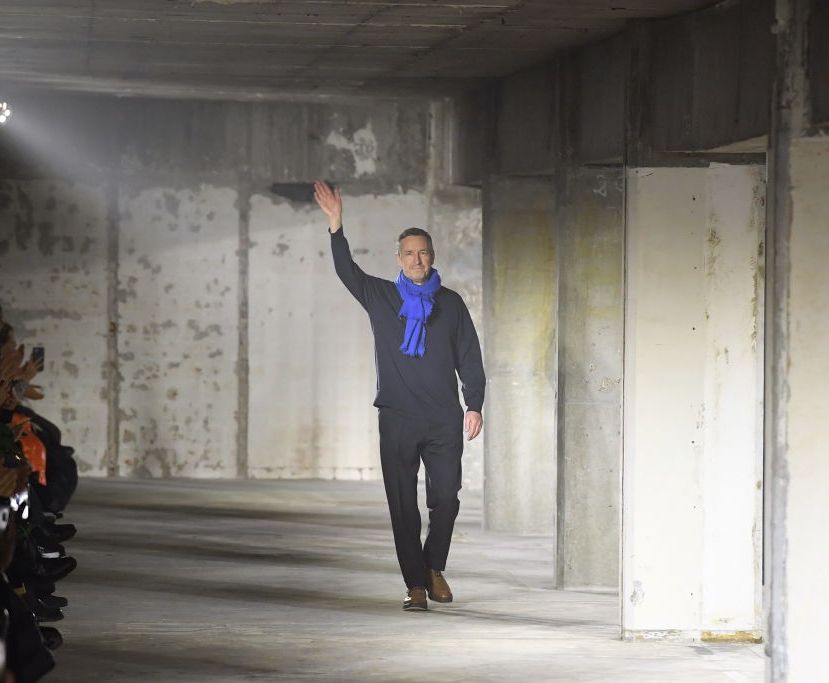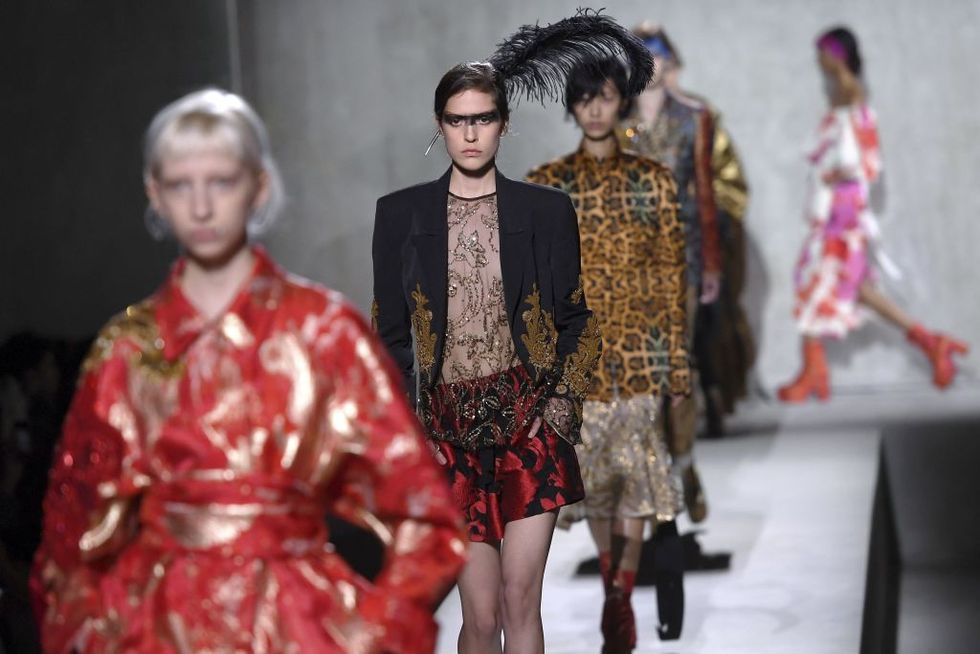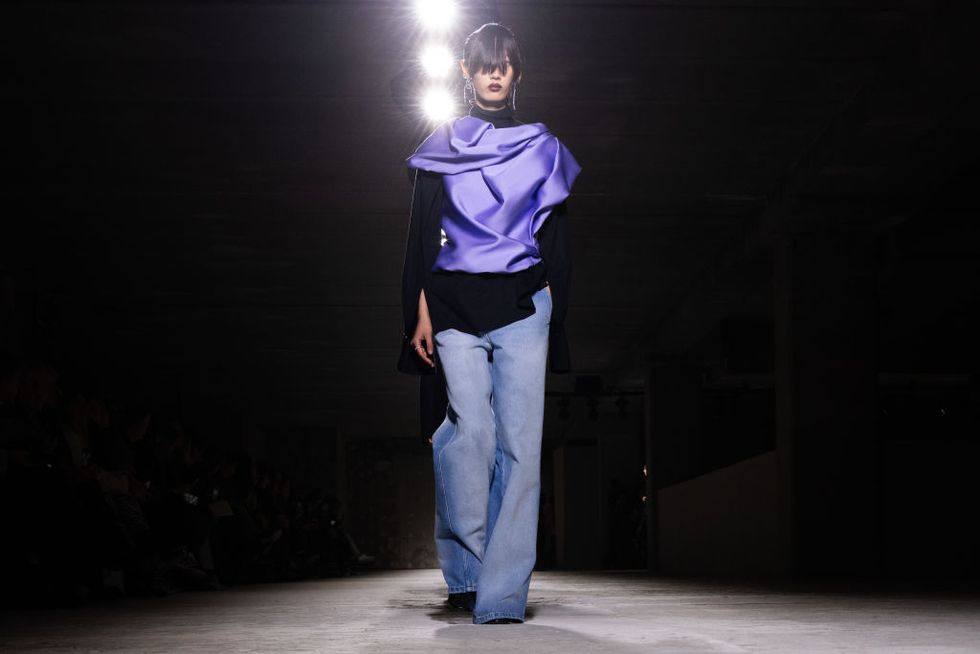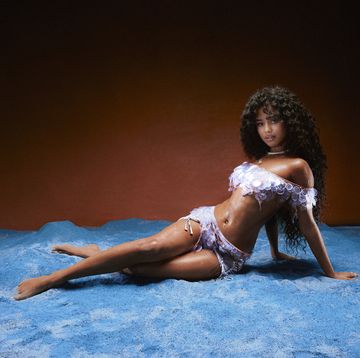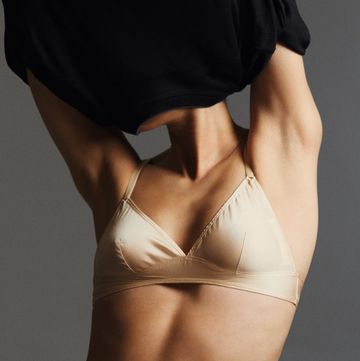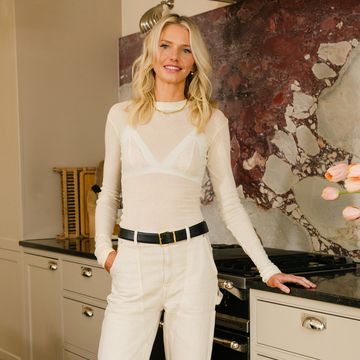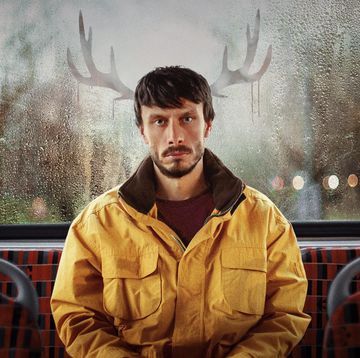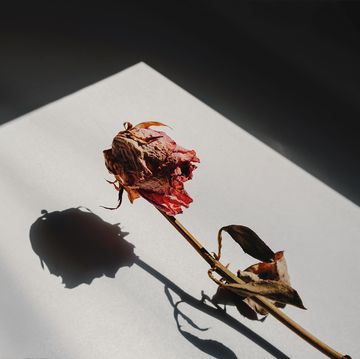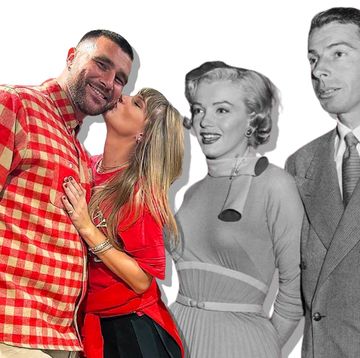This article was first published in 2018. In March 2024 the designer announced that he would be stepping down as the creative director of his eponymous brand.
Dries van Noten has just birthed a new women’s collection and is teetering on the brink of what he calls post-natal depression. In reality, he has every reason to be happy — euphoric even. The clothes, shown against the gilded grandeur of the Hotel de Ville, were an artful, yet wholly wearable mash-up of Art Deco, Art Brut and contemporary sportswear.
The 108-year-old fashion bible Women’s Wear Daily referred to the work as ‘a compelling reminder that sometimes, the pure fashion experience is enough.’ By all accounts, the show was a success. Most designers in his shoes would be thrilled. But Dries is not most designers.
He’s exceptional, and tells me a moment of self-scrutiny and dissatisfaction is inevitable, which is surprising. Despite nearly four decades in the business and 101 shows under his belt, the man who is universally regarded as one of fashion’s most celebrated independent designers still finds it difficult to look back on his collection the day after a show. He blames the emotions and runaway trains of thought. ‘I’m too much of a perfectionist I think. I can’t handle the disappointment that comes the day after. So it’s better that I head back to my home in Antwerp tonight and have some distance,’ he says.
FIND OUT MORE ON ELLE COLLECTIVE
We’re sitting in his office in the bohemian Marais district of Paris, surrounded by the many books and carefully curated pieces of antique furniture he’s collected over the years. The lithe Belgian, who appears more youthful than his 60 years, is all calm in the midst of organised chaos. Outside his office door, staff members are to’ing and fro’ing with richly detailed garments in hand. They're giving retailers from some of the fashion world’s most influential stores an even closer look at the vibrant prints, 1920s shapes, louche tailoring and glossy embroideries he showed less than 24 hours prior. And there is much to buy.
Retail fashion directors giddily drink in his work, selecting which pieces will top up their department store and ecommerce stock, satiating the appetite of his very large, very global fanbase. His celebrity loyalists are just as considerable and defined by intelligent, high-achieving women like Michelle Obama, Meryl Streep and Rihanna. Combined, his followers have helped drive consistent double digit growth in stores, making him one of the most successful independently owned fashion brands at a time when even the historic giants falter.
The mood in the building is bustling and upbeat. But, in the brightly lit room in which we sit, van Noten is contemplative, thinking through his next steps. ‘I can take a little time and start to see, a little bit, what I’m happy with, what I’m less happy with, the reviews, all these things like that. But also, the good thing is, we did a show and now today I’m already like 'next season' because we started the next collection for men already a few weeks ago. We don't have time to think too much because we have to continue already.’
You could say this balance of pragmatism and heart lies at the root of his success. For instance, his shows are often emotive experiences. Take his 100th anniversary show, which left editors (a notoriously poker faced bunch) smiling and teary-eyed as models young and old, all friends of the house, walked the runway. There were no Insta-bait gimmicks, no massive marketing ploys — just beautiful women, of various ages and races, in gorgeous clothes.
But Dries grounds the emotion with realism. His clothing, while intelligent, challenging and artful, never veers into a place that is so fashion that it alienates or becomes difficult to understand. It hits that sweet spot that sits at the intersection of insider cool and commercial appeal. 'It’s still very inclusive and accessible as a collection. His cuts and shapes suit so many body types and is easy to wear,' explains Harvey Nichols Head of Womenswear Buying, Hazel Catterall who says the designer is consistently among the department store's top sellers.
‘His collections are discreet — there’s nothing fashion victim-y about them,’ explains the editor Susannah Frankel, a longtime friend who collaborated with the designer on his eponymous book. 'He is a fashion designer in the most true sense of the word, passionate about his craft and always able to suspend his ego to make the people who wear his clothes happy. And they are happy!’
With many designers, the creative vision, striking runway statement and elaborate backstory trump everyday, practical wardrobe needs. But Dries is most famous for his deep understanding of what women want to wear: a beautifully tailored suit with just the right amount of slouch, an embellished skirt, rich in colour, that can go from office to gallery opening to dinner, and exquisite shirting that transcends the trend cycle, among others.
He’s that rare designer who proves wearability and creativity need not be mutually exclusive. He doesn’t worship at the altar of the trainer one moment (though his AW 2018 collection did include a very appealing track suit) and then pray to the sequin Gods the next. Dries operates on a slow burn, honing his signatures from one season to the next.
And increasingly, his consistent, quiet approach, is becoming an endangered species in an age where fashion has fallen sway to digital disruption and the fleeting attention spans of the social media influencer.
Dries is conflicted about this new era of fashion. ‘I think luxury is dead. Where in the past, luxury was going to a five-star hotel, it’s now going to a cabin high up on a mountain without wifi so you can’t be reached by email or phone. That’s now luxury,’ he says. ‘In fashion now, there’s such a bombardment of images. In the past, there were two show seasons a year for men and women. Now, it’s full-time.'
'There are the see now/buy now kinds of things. And the shows that take place during couture, but aren’t really couture. And then the shows that happen during women’s season, but there are men walking around. Wait, what season is this now?’ he says. ‘I know fashion very well and even I can’t follow it anymore. And so when the consumer — by the way, I think this is a very ugly word — can’t follow it anymore, they disconnect. That’s a pity. Because I think fashion is too beautiful to ruin in this way,’ he says.
He’s even less convinced by the rise of activism in fashion, as designers take to the runway to resist through a pointed slogan here, a mock protest there. ‘I think the first person [to engage with activism} was Katherine Hamnett. And she did it in a very good way, a very honest way. And it wasn’t just to sell t-shirts. Now there are a lot [of designers] doing it for sales, and that makes me angry.’
Van Noten steers clear of grand statements. ‘What I try to do with my clothes is give men and women elements which they can use to express themselves. In my vision everybody has to get dressed, I want to show options. 'You can do it like this, you can wear it like that, with high shoes, low shoes, boots.' We show it with younger women, with older women, different types of women, softer ones, more sexy ones, harder ones.
What I’m really happy with is that the selection that they have at Liberty is completely different from what they have at Selfridges is completely different to what they have at Browns. The same collection, sometimes the same pieces even, but with different focus,’ he says. ‘I’m a businessman, I have to see that my company stays healthy. But, I also really want to do things that are completely free and open.’
Van Noten developed an understanding of the business side of fashion at a young age, growing up in Antwerp in a family with two generations of tailors. 'I have a very traditional Belgian, bourgeois upbringing. My father, my grandfather worked in clothes and my father opened his store when I was twelve years old. So automatically, of course, I would make my homework and then run around in the store, unpack the new deliveries and things like that.’
While most kids spent their school holidays on family trips to sunny islands or idyllic countrysides, van Noten spent his on buying trips, accompanying his parents to fashion shows such as Pitti Uomo in Florence. ‘It made a huge impression and I really liked it.’ He goes on, ‘Then, of course, early 1970s I start to look at more TV and saw David Bowie performing Jean Genie and your eyes are opening.'
'Also, discovering when you are 15, 16 that you are gay is also of course not the easiest thing when you are in that type of family. I think your education, your upbringing, your school, everything, creates who you are, if you want it or not. You can’t say ‘away!’ For me, it’s all part of my life, it made me the person I am.’
He eventually went to Antwerp’s Royal Academy of Fine Arts where he would meet fellow students Walter Van Beirendonck, Ann Demeulemeester, Dirk Van Saene, Dirk Bikkembergs and Marina Yee and form a loose collective that would later put Belgium on the fashion map and become the famous Antwerp Six.
They took their clothes to London. ‘We thought it was going to be very strange, fashion coming from Belgium, because fashion had to be French or English or Italian, maybe a bit of American, but still. Then there were Belgians and we said ‘it’s never going to work’, but then people were ready for the idea. It was like another new idea coming in,’ he says. 'That changed of course now, fashion is all over the world. On one side, that makes things easier. But on the other, it’s maybe less exotic, when you start now as a young designer.'
'You have other tools now. We had to go to newspaper stalls to buy magazines, to go to the last page of the magazine to see which stores were carrying which collections and write letters to them to say we were going to present things, because at the time, fax was not existing. We were making little postcards to send to all those stores to say ‘we’ve got a show in London’. Now, of course, you open your laptop and you email and you communicate on Instagram and you Twitter. It’s a completely different thing, but at the end, it’s the same thing.’
Van Noten’s long-term success as an independently owned business in an age of towering fashion conglomerates makes a strong case for taking a step back from the ‘system.’ He lives and works from Antwerp, rather than one of the four fashion capitals (though he keeps an office and studio in Paris, where he has been staging shows for many years.) And he lives an idyllic life with his partner of 32 years, Patrick Vangheluwe, in a sprawling home where they cook food from their garden and look after their dog. ‘You have to have simple things in life,’ he says.
This leads us to the subject of time off. With so much change and collective angst, it can be tempting to take a hiatus from it all. But Dries wonders what good it would do. ‘I think it’s a dream for every fashion designer to take a sabbatical of six months in one season and to just have time for yourself and to reload your batteries and think. But maybe it’s going to be difficult to start all over again, to start again. Maybe you’ll say ‘am I mad?’ ‘is this really necessary?’ because there goes a lot into it. Maybe there are ways to do it that are a less deep way than how I do it. [My work] asks a lot from me, but it gives back a lot and for me that is nice.’
ELLE Collective is a new community of fashion, beauty and culture lovers. For access to exclusive content, events, inspiring advice from our Editors and industry experts, as well the opportunity to meet designers, thought-leaders and stylists, become a member today HERE.
